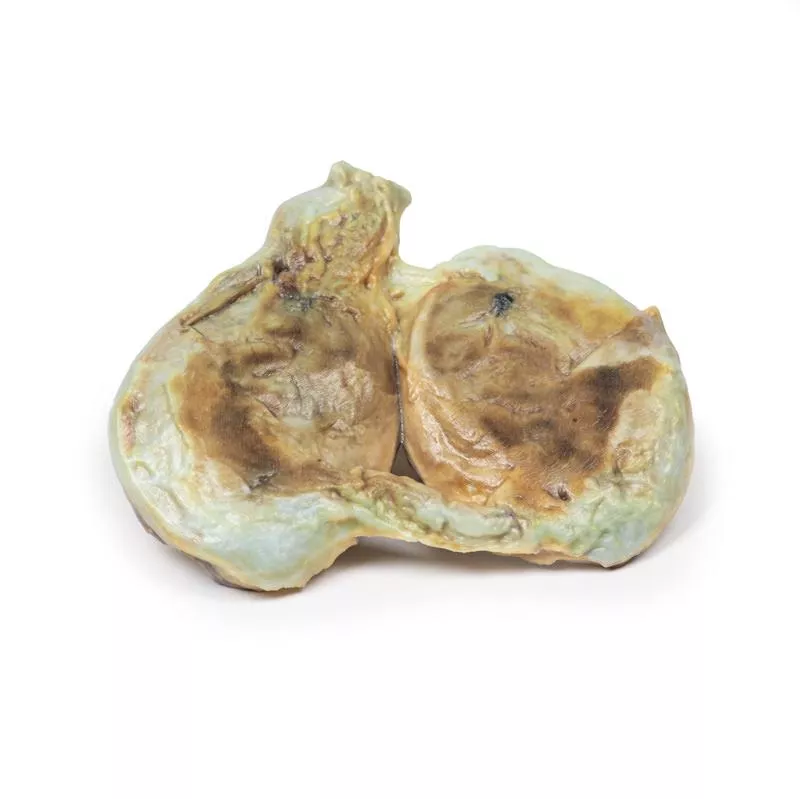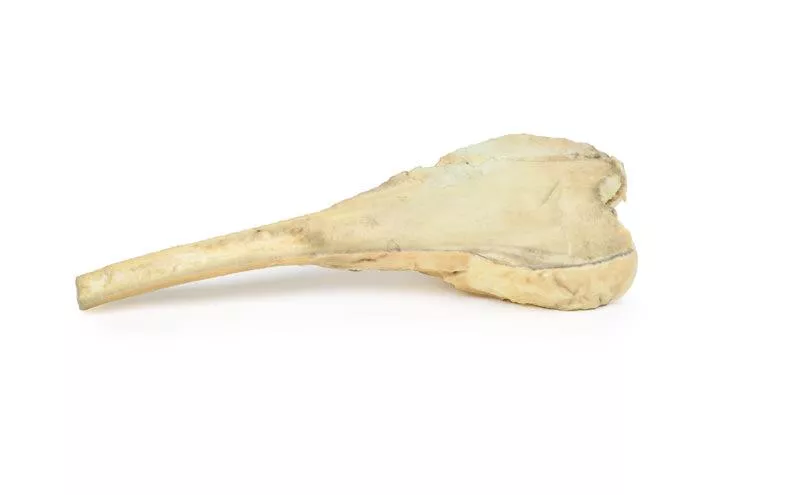Product information "Chronic hydrocoele"
Clinical History
An 80-year-old male with alcoholic liver cirrhosis and oesophageal varices presented with haematemesis. Examination showed spider naevi, large ascites, and a scrotal swelling that transmitted red light on transillumination. He had another severe haematemesis and died shortly after admission.
Pathology
The specimen includes the testis, tunica vaginalis, and spermatic cord. The tunica vaginalis is thickened with a distended cavity, while the testis is normal. This represents a chronic secondary communicating hydrocele.
Further Information
A hydrocele is fluid between the parietal and visceral layers of the tunica vaginalis. Hydroceles can be communicating (connected to the peritoneal cavity) or non-communicating. Communicating hydroceles result from failure of processus vaginalis closure and may appear at birth or later due to increased intra-abdominal pressure, like heart or liver failure. Non-communicating hydroceles arise from fluid imbalance due to infections, tumors, trauma, or lymphatic obstruction.
Patients present with a scrotal mass that may be uni- or bilateral. Communicating hydroceles can be reducible and change size with pressure; non-communicating are usually fixed. Swellings are generally painless unless complicated. Larger hydroceles may cause skin irritation or infections.
Diagnosis is clinical, aided by transillumination and ultrasound to exclude other testicular conditions. Tumor markers (AFP and B-HCG) may rule out cancer. Many congenital hydroceles resolve by age 2; persistent or symptomatic hydroceles require surgical repair to avoid hernia risk. Treating the underlying cause can also resolve reactive hydroceles.
An 80-year-old male with alcoholic liver cirrhosis and oesophageal varices presented with haematemesis. Examination showed spider naevi, large ascites, and a scrotal swelling that transmitted red light on transillumination. He had another severe haematemesis and died shortly after admission.
Pathology
The specimen includes the testis, tunica vaginalis, and spermatic cord. The tunica vaginalis is thickened with a distended cavity, while the testis is normal. This represents a chronic secondary communicating hydrocele.
Further Information
A hydrocele is fluid between the parietal and visceral layers of the tunica vaginalis. Hydroceles can be communicating (connected to the peritoneal cavity) or non-communicating. Communicating hydroceles result from failure of processus vaginalis closure and may appear at birth or later due to increased intra-abdominal pressure, like heart or liver failure. Non-communicating hydroceles arise from fluid imbalance due to infections, tumors, trauma, or lymphatic obstruction.
Patients present with a scrotal mass that may be uni- or bilateral. Communicating hydroceles can be reducible and change size with pressure; non-communicating are usually fixed. Swellings are generally painless unless complicated. Larger hydroceles may cause skin irritation or infections.
Diagnosis is clinical, aided by transillumination and ultrasound to exclude other testicular conditions. Tumor markers (AFP and B-HCG) may rule out cancer. Many congenital hydroceles resolve by age 2; persistent or symptomatic hydroceles require surgical repair to avoid hernia risk. Treating the underlying cause can also resolve reactive hydroceles.
Erler-Zimmer
Erler-Zimmer GmbH & Co.KG
Hauptstrasse 27
77886 Lauf
Germany
info@erler-zimmer.de
Achtung! Medizinisches Ausbildungsmaterial, kein Spielzeug. Nicht geeignet für Personen unter 14 Jahren.
Attention! Medical training material, not a toy. Not suitable for persons under 14 years of age.






































